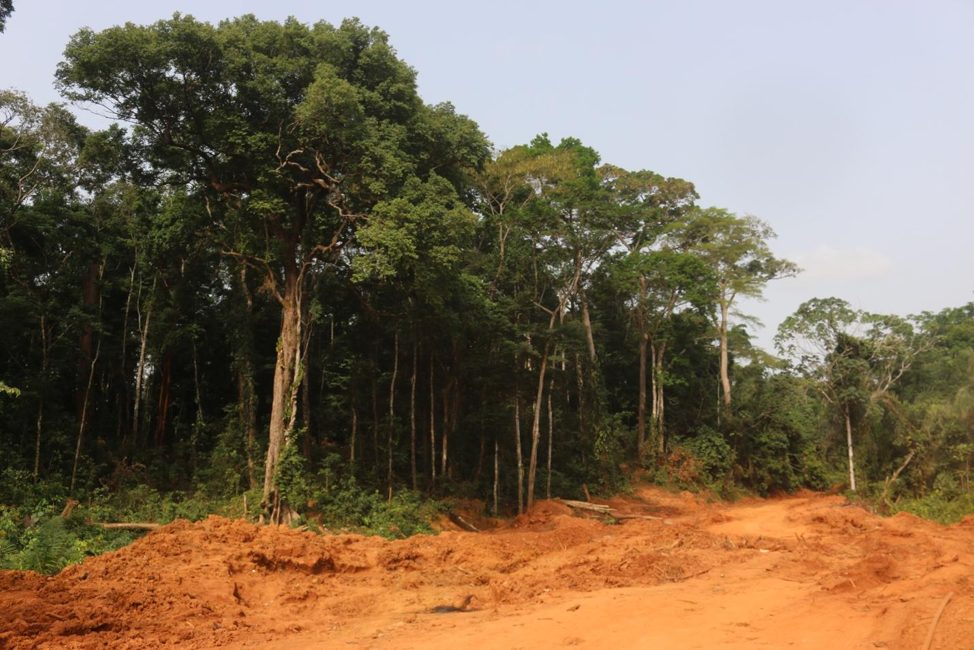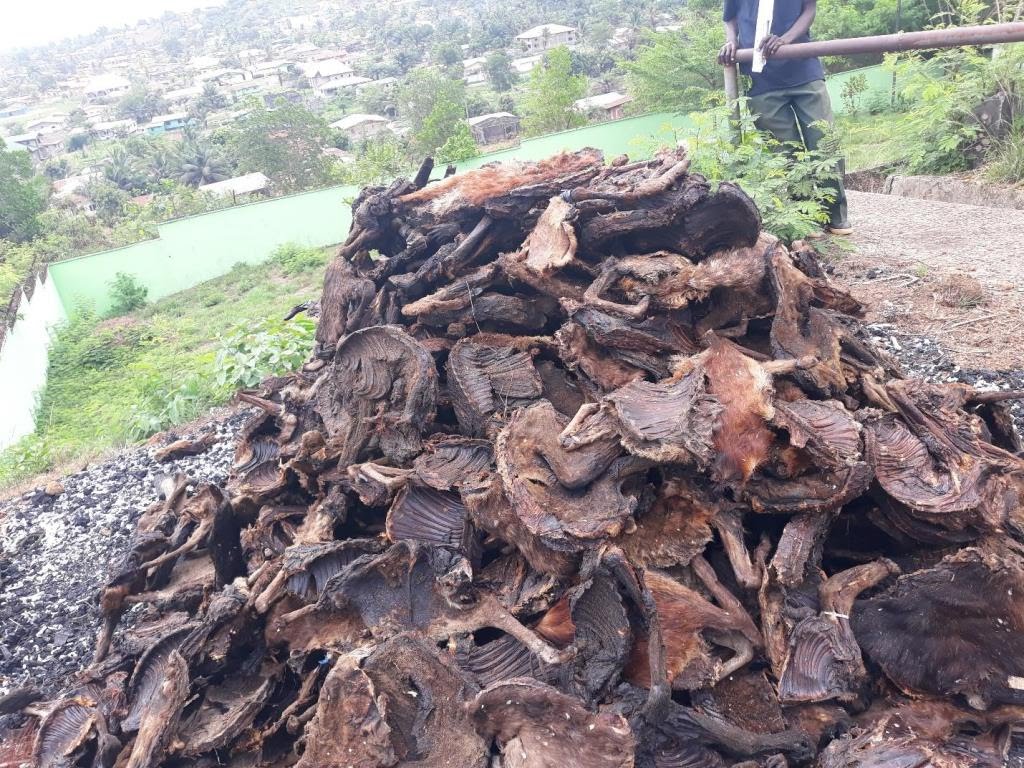Top: A pile of meat about to be set ablaze at the headquarters of the Forestry Development Authority (FDA) in Paynesville. Photo credit: FDA
By Dounard Bondo
MONROVIA – In Liberia, forests make up more than two-thirds of the country’s land area and cover approximately 6.69 million hectares. As half of Liberia’s population lives within 2.5 kilometers of a forest, the forest and its resources have become vital to the survival of most of the population who largely depend on it for food.
But the consequent rise in human contact with wildlife has increased the possibility of zoonotic diseases; which are infectious diseases that can be transmitted from animals to humans through direct contact or through food, water, or the environment.
Liberia is no stranger to the deadly consequences of zoonotic diseases. In 2014, the country recorded its first case of Ebola, a virus scientists believe can be transmitted from fruit bats and monkeys. At the end of the outbreak in 2016, it had recorded 10,678 cases with 4,810 confirmed deaths, the worst in the sub-region.
Known as one of the deadliest viruses to humans, Ebola can cause severe bleeding, organ failure and death. The virus can be easily spread, as it can be transmitted through the body fluids of an infected person, especially dead bodies.
According to the American Center for Disease Control, while scientists do not know where Ebola virus comes from, they believe it is animal-borne, with bats or monkeys being the most likely source.
“I remember when the virus came, people were just dying, one person would fall sick and the next thing is the people in the whole house they are staying in would die,” says Siah Peters, a 38-year-old farmer from Voinjama, who witnessed the Ebola outbreak in 2014.
“Ebola killed my sister and her family. Someone in their house got it, then it spread, that’s how they died one by one, we could not even bury her, the government took the body away to burn it,” she adds.
With Liberia being home to large sections of the Upper Guinea rainforest, the country remains vulnerable to Ebola and other zoonotic diseases. However, Ebola resurfaced in Uganda, Sudan and Congo last year. In Liberia, a community health worker program and a law against hunting some of the animals that cause Ebola is helping to reduce the likelihood of another outbreak, while protecting Liberia’s wildlife.
“Liberia is at risk for zoonotic diseases because of many factors. One of the factors is the clearing of forests by humans in search of food which exposes them to wildlife,” says Mildred Bembo Harris, a public health professional and the Liberian country team leader of STOP Spillover – a USAID-funded global project which is working to prevent zoonotic diseases and their spillover.
“Some of this wildlife have diseases that could spill over from animals to humans. For example, the Ebola outbreak is believed to have come from fruit bats that are still consumed in some quarters,” Harris adds.
The program enlists people in rural areas to serve as the first line of defense through a community healthcare program. Since the launch of the community healthcare program in 2016, the Liberian Ministry of Health has stated that there are now around 4,000 community health workers serving the country’s 15 counties. They not only provide services for people in rural areas, thus increasing access to healthcare, but also serve as the focal point for the observation and reporting of zoonotic diseases.
The first phase of the program in the country depended on volunteers in suburban and urban regions. Using the results of those evaluations, the Ministry of Health and Last Mile Health, its non-governmental organization (NGO) partner, launched an initiative in 2012 to bring paid health workers to rural areas.
The results of the pilot program showed that prenatal care and other preventive health services were much more accessible to low-income and rural families. The ministry then used it to test and adjust the program’s components before rolling it out on a countrywide scale in 2016.
As part of the program, health workers undergo months of training in malaria diagnosis, first aid, and maternity health after being nominated by their fellow villagers and passing a literacy test. Then, they start talking to people in their community, addressing any problems that arise, and collecting data on local homes to address health concerns.
“This is integral as local communities do not just have little access to healthcare, but they are also at the higher risk of zoonotic diseases… because local populations hunt wildlife for food,” says Bernice T. Dahn, a former Deputy Minister for Health Services and Chief Medical Officer of the Republic of Liberia.
This view is reinforced by Harris who says “The community health workers have been a great asset to the country as they serve in rural and remote communities. There are several diseases and viruses that Liberia is on the watch out for due to public health concerns. These health workers help with surveillance in communities by reporting on time so that any potential outbreak is detected timely and responded to prevent its spread.”
A Ban On Hunting Protected Species
In addition to the community healthcare program, the Forest Development Agency (FDA) is also implementing the Wildlife and Protected Area Management Law of 2016 that bans the hunting of certain protected species for bushmeat.
The ban is not only protecting wildlife, but it is also helping to combat the spread of zoonotic diseases as It covers chimpanzees, four different species of monkeys, and bush hogs—all with a history of transmitting zoonotic diseases.
The ban is important as societal attitudes towards the consumption of bushmeat helped spread zoonotic diseases like Ebola. “When Ebola first came, we thought it was witchcraft or poison, but the government told us that it was the monkey and bush meat that we used to eat, we did not believe it at first because we have been eating it for long,” says Martha Johnson, a 40-year-old trader in Ganta, Nimba county.
Violators of the ban face a fine of US$5,000 to US$10,000 dollars or a two to a four-year jail term for any person found guilty. Additionally, the law also requires that any dead wildlife, seized or confiscated by the Authority may be quarantined, destroyed, or delivered to the appropriate governmental agency.
While the country had originally placed a temporary ban on bush meat consumption during the Ebola outbreak in 2014, post-Ebola saw an increase in both the supply and demand for bushmeat.
In response, FDA officers have positioned themselves in forest communities where they seize and destroy piles of bushmeat gotten from protected species as a means to deter the practice.
“I used to sell bushmeat before but I stopped because the FDA agent will take it all away from you and you will lose the money you put in it,” says Peters. Additionally, the government and international partners have also begun training ex-bushmeat sellers in other life skills. The purpose of the training is to encourage the sellers to switch to a legitimate line of work rather than continuing the unlawful trade of wildlife.
“I also heard on the radio that Ebola was in Congo this year, I hope it doesn’t come to Liberia, we suffered from it already,” Peters adds.
Gender Impact on the Community Health Program
The suffering Peters speaks of exceeds not just the physical and emotional impact of Ebola but also the specific gendered impact on women and girls.

According to a report by Oxfam – an international NGO which works in Liberia, anecdotal evidence suggests that more women contracted the virus than men owing to their caregiving roles within the home and society. This role was even more prevalent during Ebola as formal healthcare provision was weak and often inaccessible.
“We women really suffered during Ebola; we were just dying. And it was spreading fast among us because when anybody is sick in the house, it’s their ma that’s responsible, it’s also us that can go to the market for food, so I am not surprised that the virus really spread among us,” says Johnson.
Additionally, women in the healthcare sector who served primarily as nurses, midwives, and traditional birth attendants, were severely affected by Ebola. During the epidemic, Liberia lost eight percent of its doctors, nurses, and midwives to Ebola, many of which were women.
Pregnant women who already had limited access to quality health care lost crucial resources due to Ebola. Consequently, the epidemic resulted in an upsurge in the number of avoidable deaths of pregnant women. It was widely reported that pregnant women were being turned away from clinics and forced to give birth in the street, in cars, or in their own houses.
For Peters, Johnson and many other Liberians who witnessed Ebola, there is the hope that the measures taken are adequate to prevent the next zoonotic disease outbreak.
“We really suffered, I hope Ebola or anything that’s like never comes back again,” Johnson says.
This story was produced with the support of a grant from Internews’ Earth Journalism Network.




